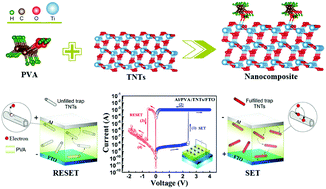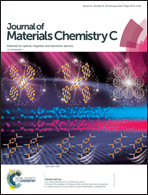Comprehensive resistive switching behavior of hybrid polyvinyl alcohol and TiO2 nanotube nanocomposites identified by combining experimental and density functional theory studies†
Abstract
To date, hybrid polyvinyl alcohol (PVA) and TiO2 nanocomposites have been widely studied for numerous practical applications including enhanced visible-light photocatalytic activities, shield coatings against UV light, electrolyte membranes for fuel cells, hybrid fibers and proton conduction layers in biological systems. However, the properties of interaction between PVA and the TiO2 surface, particularly the band offset of organic–inorganic constituents, are still unclear and under debate. In this work, we studied the resistive switching characteristics and mechanism of hybrid PVA and TiO2 nanotube (TNT) nanocomposites. By embedding TNTs into the PVA matrix, the resistive switching performance of devices is significantly enhanced, with an excellent retention of 104 seconds and large resistance ratio >104. Density functional theory (DFT) calculations confirmed that strong bonds were formed between the O atoms in PVA's OH groups and the five-coordinated Ti atoms on the surface of TiO2, corresponding to the significant decrease of vibrational intensity of the OH-group in the FTIR spectra. In addition, band offsets of the TiO2/PVA interface illustrated the very low minimum conduction band energy level of TiO2 compared to that of crystalline PVA, implying that TNTs act as trap centers for electrons in the insulating layer. Consequently, the current transport and switching mechanisms of the devices were suggested using the models of trap controlled space-charge-limited conduction and the charge carrier trapping–de-trapping process at the centers of TNTs in the PVA polymer matrix, respectively.



 Please wait while we load your content...
Please wait while we load your content...